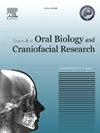Association of smokeless tobacco with periodontal health of patients seeking treatment at a Dental Hospital setting in Sri Lanka
Q1 Medicine
Journal of oral biology and craniofacial research
Pub Date : 2025-03-26
DOI:10.1016/j.jobcr.2025.03.011
引用次数: 0
Abstract
Introduction
Betel chewing has indeed been an integral part of many cultures in South Asia and beyond for centuries. The practice involves the combination of various ingredients, including areca nut (also known as betel nut), slaked lime, and often tobacco, all wrapped in a betel leaf. This mixture is chewed for its stimulating and psychoactive effects. In addition to its widespread cultural significance, betel chewing has been linked to social rituals, celebrations, and even medical practices in some regions. Despite its cultural importance, it's important to note the health concerns associated with betel chewing. The use of areca nut has been linked to an increased risk of oral cancers, gum disease, and other health issues. Some studies also indicate that the combination of areca nut and tobacco significantly raises the risk of developing these conditions.
Main objective
To assess any association of smokeless tobacco (SLT) with periodontal health of patients seeking dental treatment.
Specific objectives
To assess the association of periodontal status with oral hygiene habits of patients seeking dental treatment.
To assess the association between smokeless tobacco use with plaque score, bleeding score, BPE (Basic Periodontal Examination) scores and pocket depth measurements.
Materials and method
This was a cross sectional descriptive study, conducted among adult patients above the age of 18 years, randomly selected from the daily diagnostic clinic of the Dental (Teaching) Hospital, Peradeniya (DTHP), Sri Lanka. The sample size was calculated by using Lawanga and Lamshow sample size calculation method (Lwanga & Lemeshow, 1991) ensuring a 95 % confidence level and 80 % power and a systematic sampling technique. The study instrument was a check-list to obtain socio demographic information and periodontal health status.
Results
A total of 355 adult patients were included in the study, with a mean age of 38 (SD ± 15.2 years) and the age range between 18 and75 years. Out of the total study sample, 120 (34 %) were male and 235 (66 %) were female.
It was identified that age is significantly associated with severe periodontal disease (p < 0.001, OR = 1.043 per year increase) and Plaque score percentile is a strong predictor (p < 0.001, OR = 1.87), indicating a higher plaque score is linked to severe periodontal destruction.
The inferential statistics revealed that there was a statistically significant increase in the plaque scores (P = 0.007), bleeding scores (P = 0.007) and BPE scores (P = 0.003) in smokeless tobacco users when compared with those who do not use smokeless tobacco. Moreover, the periodontal pocket depths (PPD) of smokeless tobacco (SLT) users were significantly greater (P = 0.023) than those of tobacco nonusers (NSLT). Among the SLT users, and those who had good oral health habits which was assessed in related to their brushing frequency, showed no significant association across their periodontal (PDD) pocket depths resembling their PDD health.
Conclusion
The results indicated that smokeless tobacco is detrimental to periodontal health. Habit intervention and reduction in the consumption of smokeless tobacco may significantly reduce periodontal disease, and therefore, these preventive measures should be encouraged in SLT users.

无烟烟草与在斯里兰卡牙科医院寻求治疗的患者牙周健康的关系
导言几个世纪以来,咀嚼槟榔确实已成为南亚及其他地区许多文化不可或缺的一部分。嚼槟榔的做法是将槟榔(又称槟榔)、熟石灰和烟草等多种成分混合在一起,并用槟榔叶包裹。咀嚼这种混合物可产生刺激和精神作用。嚼食槟榔除了具有广泛的文化意义外,还与一些地区的社会仪式、庆祝活动甚至医疗实践有关。尽管嚼食槟榔具有重要的文化意义,但必须注意与嚼食槟榔有关的健康问题。使用槟榔与口腔癌、牙龈疾病和其他健康问题的风险增加有关。主要目标评估无烟烟草(SLT)与寻求牙科治疗的患者的牙周健康之间的关系。评估无烟烟草的使用与牙菌斑评分、出血评分、BPE(基本牙周检查)评分和牙周袋深度测量之间的关联。材料与方法这是一项横断面描述性研究,研究对象是从斯里兰卡佩拉德尼亚牙科(教学)医院(DTHP)的日常诊断诊所中随机抽取的 18 岁以上成年患者。样本量采用 Lawanga 和 Lamshow 样本量计算方法(Lwanga & Lemeshow, 1991)计算,确保置信度为 95%,功率为 80%,并采用系统抽样技术。研究工具是一份检查表,用于获取社会人口学信息和牙周健康状况。结果 共有 355 名成年患者参与了研究,平均年龄为 38 岁(SD ± 15.2 岁),年龄范围在 18 岁至 75 岁之间。研究发现,年龄与严重牙周病显著相关(p < 0.001,OR = 1.043/年增长),牙菌斑评分百分位数是一个强有力的预测因子(p < 0.001,OR = 1.87/年增长)。推论统计显示,与不使用无烟烟草者相比,使用无烟烟草者的牙菌斑评分(P = 0.007)、出血评分(P = 0.007)和 BPE 评分(P = 0.003)均有统计学意义的显著增加。此外,使用无烟烟草(SLT)者的牙周袋深度(PPD)明显大于不使用无烟烟草者(NSLT)(P = 0.023)。在无烟烟草使用者中,那些有良好口腔卫生习惯(通过刷牙频率进行评估)的人的牙周袋深度与他们的牙周袋健康状况没有明显关联。习惯干预和减少无烟烟草的消费可大大减少牙周疾病,因此,应鼓励无烟烟草使用者采取这些预防措施。
本文章由计算机程序翻译,如有差异,请以英文原文为准。
求助全文
约1分钟内获得全文
求助全文
来源期刊

Journal of oral biology and craniofacial research
Medicine-Otorhinolaryngology
CiteScore
4.90
自引率
0.00%
发文量
133
审稿时长
167 days
期刊介绍:
Journal of Oral Biology and Craniofacial Research (JOBCR)is the official journal of the Craniofacial Research Foundation (CRF). The journal aims to provide a common platform for both clinical and translational research and to promote interdisciplinary sciences in craniofacial region. JOBCR publishes content that includes diseases, injuries and defects in the head, neck, face, jaws and the hard and soft tissues of the mouth and jaws and face region; diagnosis and medical management of diseases specific to the orofacial tissues and of oral manifestations of systemic diseases; studies on identifying populations at risk of oral disease or in need of specific care, and comparing regional, environmental, social, and access similarities and differences in dental care between populations; diseases of the mouth and related structures like salivary glands, temporomandibular joints, facial muscles and perioral skin; biomedical engineering, tissue engineering and stem cells. The journal publishes reviews, commentaries, peer-reviewed original research articles, short communication, and case reports.
 求助内容:
求助内容: 应助结果提醒方式:
应助结果提醒方式:


